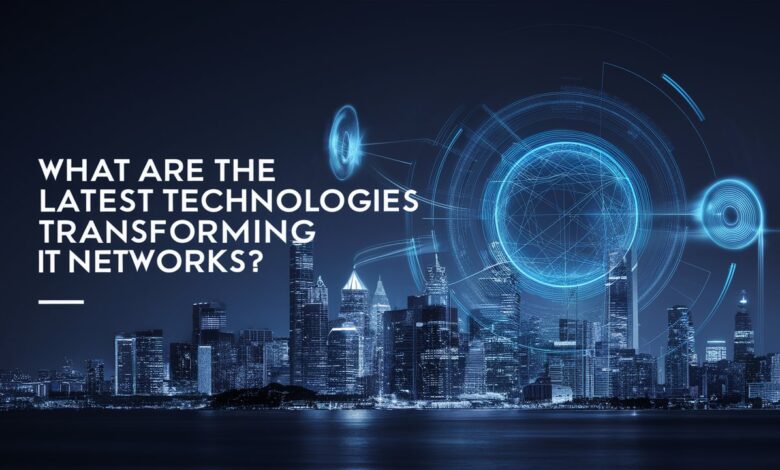What Are the Latest Technologies Transforming IT Networks?
Discover the cutting-edge tech reshaping IT networks, from AI to 5G, and how they're driving efficiency.

Visualize a world where your company’s network anticipates and resolves issues before they occur, where data flows seamlessly across continents at lightning speed, and where security adapts in real time to thwart evolving threats. This isn’t science fiction. It’s the reality of today’s innovative IT networks.
Gone are the days of clunky hardware and rigid infrastructures. The new era of networking is fluid, intelligent, and borderless. Think of networks that mold themselves to your business needs, expanding and contracting like a living organism. These adaptive systems are no longer confined to the realm of tech giants. They’re accessible to businesses of all sizes, ready to revolutionize operations from the ground up.
But what’s driving this seismic shift? It’s a perfect storm of innovations—from the ethereal promise of cloud-native architectures to the tangible power of artificial intelligence coursing through network veins.
Latest Technologies Transforming IT Networks
Software-Defined Networking (SDN)
Software-defined networking represents a paradigm shift in network architecture and management. By decoupling the control plane from the data plane, SDN enables centralized network provisioning and management, offering unprecedented flexibility and control over network resources. This technology allows network administrators to respond quickly to changing business requirements, optimize network performance, and reduce operational costs.
Key benefits of SDN include:
- Improved network programmability and automation
- Enhanced scalability and agility
- Simplified network management and configuration
- Reduced hardware dependency and vendor lock-in
As SDN continues to mature, it is becoming an essential component to manage IT support Toronto, particularly in data centers and large enterprise environments. Organizations leveraging SDN can more easily implement complex network policies, improve security posture, and adapt to evolving traffic patterns.
Read More Article: How to Ensure Network Uptime and Minimize Downtime
Network Function Virtualization (NFV)
Network Function Virtualization complements SDN by virtualizing network services traditionally performed by dedicated hardware appliances. NFV allows network functions such as firewalls, load balancers, and routers to be deployed as software instances on standard servers, reducing the need for specialized hardware and simplifying network infrastructure.
NFV offers several advantages:
- Lower capital and operational expenses
- Faster deployment of new network services
- Improved resource utilization and energy efficiency
- Enhanced flexibility in scaling network functions
By adopting NFV, organizations can create more dynamic and adaptable networks that can quickly respond to changing demands. This technology is particularly beneficial for telecommunication providers and large enterprises seeking to optimize their network resources and reduce costs.
Intent-Based Networking (IBN)
Intent-Based Networking represents the next evolution in network management, leveraging artificial intelligence and machine learning to create self-operating networks. IBN systems translate business intentions into network configurations, continuously monitor network performance, and automatically adjust settings to maintain desired outcomes.
Key features of IBN include:
- Automated network configuration and optimization
- Continuous validation of network state against business intent
- Proactive identification and resolution of network issues
- Enhanced network visibility and analytics
IBN promises to simplify complex network operations, reduce human errors, and improve overall network performance and reliability. As this technology matures, it is expected to play a crucial role in managing large-scale, dynamic network environments.
5G and Wi-Fi 6
The advent of 5G cellular networks and Wi-Fi 6 (802.11ax) is revolutionizing wireless connectivity, offering unprecedented speeds, lower latency, and improved device density support. These technologies are enabling new use cases and applications that were previously impractical due to network limitations.
5G and Wi-Fi 6 bring several enhancements:
- Gigabit-speed wireless connections
- Reduced latency for real-time applications
- Improved performance in high-density environments
- Enhanced power efficiency for mobile devices
As these technologies become more widespread, they will facilitate the growth of Internet of Things (IoT) deployments, enable new edge computing applications, and support advanced use cases such as augmented reality and autonomous vehicles.
Network Automation and Orchestration
Network automation and orchestration tools are becoming increasingly sophisticated, allowing organizations to streamline their network operations and reduce manual intervention. These solutions leverage APIs, scripting languages, and machine learning algorithms to automate routine tasks, enforce policies, and orchestrate complex network changes.
Benefits of network automation include:
- Reduced operational costs and human errors
- Faster deployment of network services and changes
- Improved compliance and security posture
- Enhanced network visibility and troubleshooting capabilities
As networks grow more complex, automation becomes essential for maintaining efficiency and reliability. Advanced orchestration platforms are enabling organizations to manage multi-cloud and hybrid network environments with greater ease and consistency.
Secure Access Service Edge (SASE)
Secure Access Service Edge is an emerging network architecture that combines network security functions with WAN capabilities to support the dynamic secure access needs of digital organizations. SASE delivers security and networking services from a unified cloud-native platform, addressing the challenges of distributed workforces and cloud-based applications.
Key components of SASE include:
- Cloud-native security services (e.g., CASB, SWG, ZTNA)
- Software-defined WAN (SD-WAN) capabilities
- Identity-based access control
- Centralized policy management and enforcement
By adopting SASE, organizations can simplify their network and security infrastructure, improve performance for remote users, and enhance their overall security posture in a cloud-first world.
Read More Article: Network Issues: Common Problems and Solutions
Artificial Intelligence for IT Operations (AIOps)
AIOps platforms are leveraging artificial intelligence and machine learning to revolutionize IT operations management. These tools analyze vast amounts of network and operational data to provide insights, predict issues, and automate responses to network events.
AIOps offers several advantages:
- Proactive identification of network anomalies and potential issues
- Automated root cause analysis and problem resolution
- Enhanced capacity planning and performance optimization
- Improved incident management and mean time to repair (MTTR)
As networks become more complex and generate increasing volumes of data, AIOps will play a crucial role in maintaining network health, optimizing performance, and reducing operational overhead.
Takeaway
Just a decade ago, the idea of a self-healing, AI-driven network that spans the globe yet operates as a single, seamless entity seemed like a pipe dream. Today, it’s a reality within reach of businesses of all sizes. These advancements aren’t just about faster speeds or fancier gadgets. They’re about fundamentally changing how we work, communicate, and innovate. They’re about turning your IT network from a cost center into a powerhouse of productivity and innovation.





